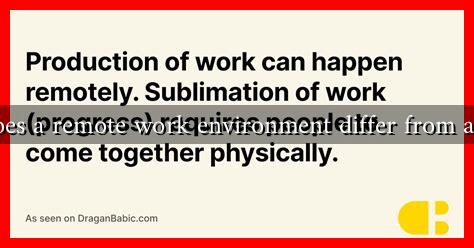-
Table of Contents
How Does a Remote Work Environment Differ from an Office?
The rise of remote work has transformed the traditional workplace landscape, especially in the wake of the COVID-19 pandemic. As companies adapt to this new normal, understanding the differences between remote work environments and traditional office settings is crucial for both employers and employees. This article explores these differences, highlighting the advantages and challenges of each setup.
Work Environment and Culture
One of the most significant differences between remote work and office work is the physical environment and the culture that develops within it.
- Physical Space: In an office, employees share a physical space that fosters collaboration and spontaneous interactions. In contrast, remote work often means employees are spread across various locations, working from home, co-working spaces, or even cafes.
- Company Culture: Office environments often cultivate a strong company culture through in-person interactions, team-building activities, and shared experiences. Remote work can lead to feelings of isolation, making it essential for companies to find innovative ways to maintain their culture.
Communication Styles
Communication is another area where remote work and office environments diverge significantly.
- Face-to-Face Interaction: In an office, employees can engage in face-to-face conversations, which can enhance understanding and rapport. Non-verbal cues, such as body language, play a crucial role in effective communication.
- Digital Communication: Remote work relies heavily on digital communication tools like Slack, Zoom, and email. While these tools facilitate communication across distances, they can also lead to misunderstandings and a lack of personal connection.
Work-Life Balance
Remote work offers unique advantages and challenges regarding work-life balance.
- Flexibility: Remote work often provides employees with greater flexibility in managing their schedules. This can lead to improved work-life balance, as employees can tailor their work hours to fit personal commitments.
- Blurred Boundaries: However, the lack of a physical separation between work and home can lead to longer working hours and difficulty disconnecting from work. A study by Buffer found that 22% of remote workers struggle with unplugging after work hours.
Productivity and Performance
Productivity levels can vary significantly between remote and office environments, influenced by various factors.
- Distractions: While offices can be noisy and distracting, remote workers may face interruptions from family members, pets, or household chores. A study by FlexJobs found that 65% of remote workers reported being more productive at home than in an office.
- Autonomy: Remote work often allows for greater autonomy, enabling employees to work in ways that suit their personal productivity styles. This can lead to increased job satisfaction and performance.
Technology and Tools
The reliance on technology is a defining characteristic of remote work environments.
- Collaboration Tools: Remote teams utilize various tools for project management, communication, and collaboration, such as Trello, Asana, and Microsoft Teams. These tools can enhance productivity but require employees to be tech-savvy.
- Cybersecurity: Remote work raises concerns about data security and privacy. Companies must invest in secure systems and training to protect sensitive information.
Conclusion
In summary, the differences between remote work environments and traditional office settings are profound and multifaceted. While remote work offers flexibility, autonomy, and the potential for increased productivity, it also presents challenges such as communication barriers, feelings of isolation, and blurred work-life boundaries. Companies must adapt their strategies to foster a positive remote work culture, ensuring that employees remain engaged and connected. As the future of work continues to evolve, understanding these differences will be essential for both employers and employees to thrive in their respective environments.
For further insights on remote work trends and best practices, consider exploring resources from FlexJobs.


